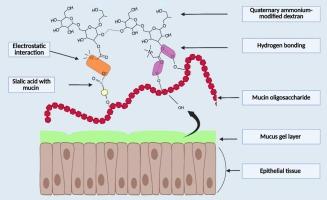季铵改性右旋糖酐:一种独特的可生物降解粘接聚合物
IF 4.3
2区 医学
Q1 PHARMACOLOGY & PHARMACY
European Journal of Pharmaceutics and Biopharmaceutics
Pub Date : 2025-06-23
DOI:10.1016/j.ejpb.2025.114788
引用次数: 0
摘要
目的制备一种具有良好黏附性能和高生物相容性的阳离子葡聚糖聚合物。方法采用n -氯甜菜碱酯化法制备季铵盐改性右旋糖酐。结构表征,如zeta电位测量、酯定量、核磁共振、红外光谱和酶降解研究,以确认季铵结构与右旋糖酐主链的共价连接。通过体外HeLa和Caco-2细胞毒性分析和溶血试验评价改性葡聚糖的生物相容性。利用平板流变仪研究了改性右旋糖酐与猪黏液的相互作用。研究了猪粘膜的黏附性能。结果以640.4±9.051µmol/g酯为原料,季铵修饰右旋糖酐的zeta电位由- 25.4±0.5 mV转变为+ 15.6±0.7 mV。核磁共振和红外光谱分析证实了季铵基团与聚合物主链的共价结合。酶降解研究证实了脂肪酶介导的对改性右旋糖酐季铵部分的裂解。细胞毒性和溶血实验结果表明,季铵修饰右旋糖酐在0.5%浓度下无毒性。季铵改性右旋糖酐与黏液在3 h和6 h时的动态粘度分别比天然聚合物高2.1倍和3.6倍。此外,与天然葡聚糖相比,季铵修饰的葡聚糖对肠道粘膜的黏附性能提高了3.4倍。结论季铵修饰右旋糖酐具有良好的阳离子特性,具有良好的黏附性能和良好的生物相容性。本文章由计算机程序翻译,如有差异,请以英文原文为准。

Quaternary ammonium-modified dextran: a unique biodegradable mucoadhesive polymer
Aim
The present study aims to develop a cationic dextran polymer with improved mucoadhesive properties and high biocompatibility.
Methodology
Quaternary ammonium-modified dextran was synthesized of dextran via esterification with N-chlorobetainyl chloride. Structural characterizations like zeta potential measurements, ester quantification, NMR, FTIR, and enzymatic degradation studies were performed to confirm the covalent attachment of quaternary ammonium structure to dextran backbone. Biocompatibility of modified dextran was evaluated by in vitro cytotoxic analysis on HeLa and Caco-2 cells, and hemolysis assay. Furthermore, interaction of modified dextran with porcine mucus was evaluated by using plate rheometer. Mucoadhesive properties were investigated on porcine mucosa mimicking in vivo conditions.
Results
A shift in zeta potential from −25.4 ± 0.5 to + 15.6 ± 0.7 mV was obtained for quaternary ammonium-modified dextran with 640.4 ± 9.051 µmol/g ester content. NMR and FTIR analysis confirmed the covalent binding of quaternary ammonium moieties to the polymer backbone. Enzymatic degradation studies demonstrated the lipase-mediated cleavage of quaternary ammonium moieties from modified dextran. Cytotoxicity and hemolysis results proved that quaternary ammonium-modified dextran was not toxic up to the concentration of 0.5 %. Rheometric measurements of quaternary ammonium-modified dextran with mucus showed 2.1- and 3.6-fold higher dynamic viscosity than native polymer at 3 h and 6 h time intervals, respectively. Moreover, compared to native dextran, quaternary ammonium-modified dextran showed 3.4-fold higher mucoadhesive properties on the intestinal mucosa.
Conclusion
Because of its cationic character, quaternary ammonium-modified dextran exhibits promising potential as a biodegradable polymer with improved mucoadhesive properties and remarkable biocompatibility.
求助全文
通过发布文献求助,成功后即可免费获取论文全文。
去求助
来源期刊
CiteScore
8.80
自引率
4.10%
发文量
211
审稿时长
36 days
期刊介绍:
The European Journal of Pharmaceutics and Biopharmaceutics provides a medium for the publication of novel, innovative and hypothesis-driven research from the areas of Pharmaceutics and Biopharmaceutics.
Topics covered include for example:
Design and development of drug delivery systems for pharmaceuticals and biopharmaceuticals (small molecules, proteins, nucleic acids)
Aspects of manufacturing process design
Biomedical aspects of drug product design
Strategies and formulations for controlled drug transport across biological barriers
Physicochemical aspects of drug product development
Novel excipients for drug product design
Drug delivery and controlled release systems for systemic and local applications
Nanomaterials for therapeutic and diagnostic purposes
Advanced therapy medicinal products
Medical devices supporting a distinct pharmacological effect.

 求助内容:
求助内容: 应助结果提醒方式:
应助结果提醒方式:


